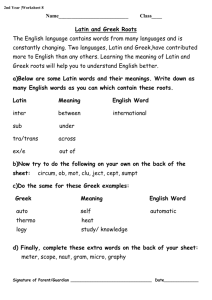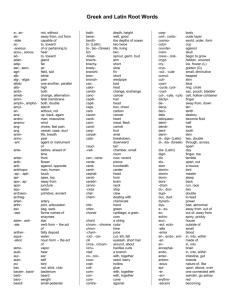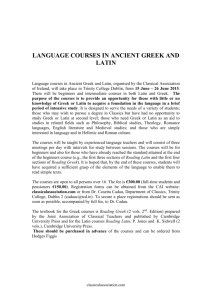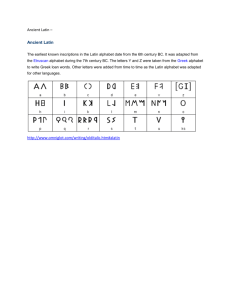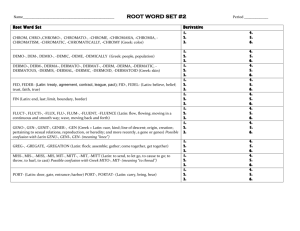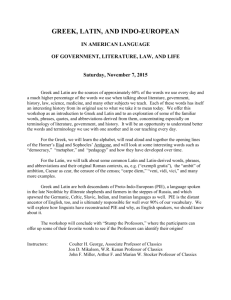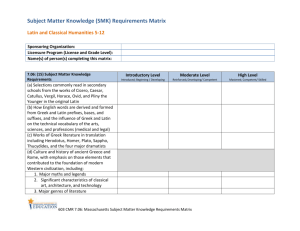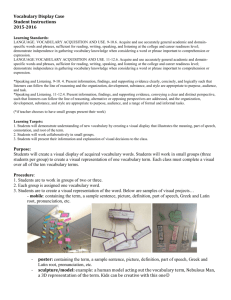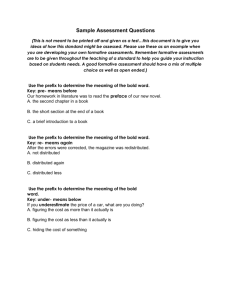An Empirical Survey of French, Latin and Greek Words in the
advertisement
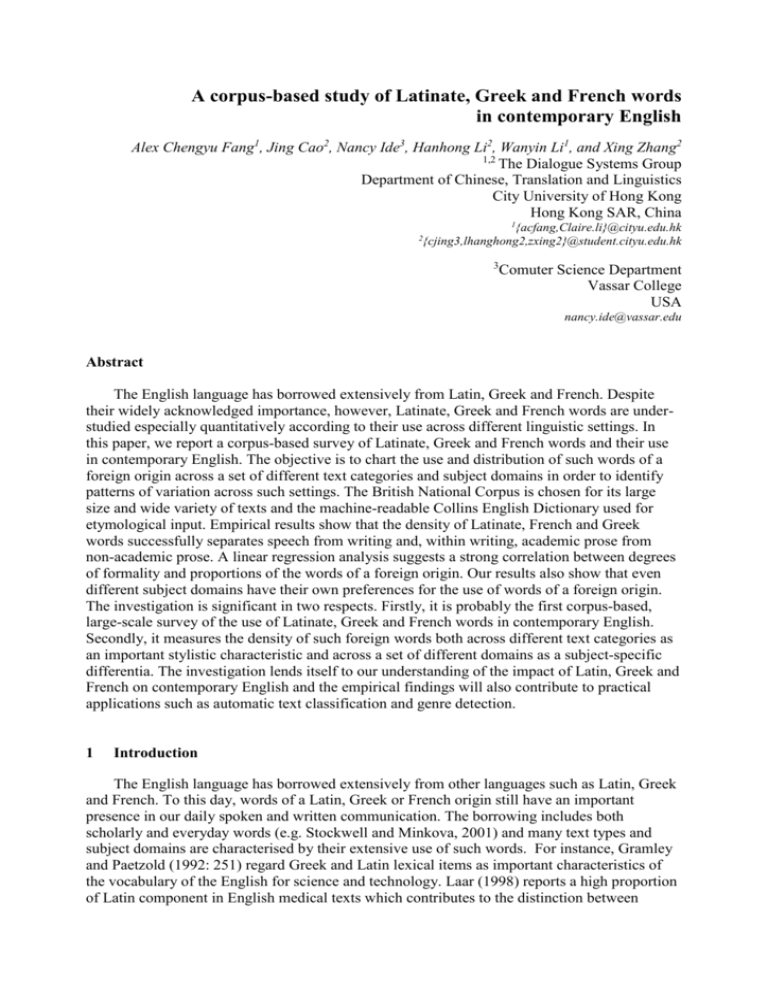
A corpus-based study of Latinate, Greek and French words
in contemporary English
Alex Chengyu Fang1, Jing Cao2, Nancy Ide3, Hanhong Li2, Wanyin Li1, and Xing Zhang2
1,2
The Dialogue Systems Group
Department of Chinese, Translation and Linguistics
City University of Hong Kong
Hong Kong SAR, China
1
{acfang,Claire.li}@cityu.edu.hk
{cjing3,lhanghong2,zxing2}@student.cityu.edu.hk
2
3
Comuter Science Department
Vassar College
USA
nancy.ide@vassar.edu
Abstract
The English language has borrowed extensively from Latin, Greek and French. Despite
their widely acknowledged importance, however, Latinate, Greek and French words are understudied especially quantitatively according to their use across different linguistic settings. In
this paper, we report a corpus-based survey of Latinate, Greek and French words and their use
in contemporary English. The objective is to chart the use and distribution of such words of a
foreign origin across a set of different text categories and subject domains in order to identify
patterns of variation across such settings. The British National Corpus is chosen for its large
size and wide variety of texts and the machine-readable Collins English Dictionary used for
etymological input. Empirical results show that the density of Latinate, French and Greek
words successfully separates speech from writing and, within writing, academic prose from
non-academic prose. A linear regression analysis suggests a strong correlation between degrees
of formality and proportions of the words of a foreign origin. Our results also show that even
different subject domains have their own preferences for the use of words of a foreign origin.
The investigation is significant in two respects. Firstly, it is probably the first corpus-based,
large-scale survey of the use of Latinate, Greek and French words in contemporary English.
Secondly, it measures the density of such foreign words both across different text categories as
an important stylistic characteristic and across a set of different domains as a subject-specific
differentia. The investigation lends itself to our understanding of the impact of Latin, Greek and
French on contemporary English and the empirical findings will also contribute to practical
applications such as automatic text classification and genre detection.
1
Introduction
The English language has borrowed extensively from other languages such as Latin, Greek
and French. To this day, words of a Latin, Greek or French origin still have an important
presence in our daily spoken and written communication. The borrowing includes both
scholarly and everyday words (e.g. Stockwell and Minkova, 2001) and many text types and
subject domains are characterised by their extensive use of such words. For instance, Gramley
and Paetzold (1992: 251) regard Greek and Latin lexical items as important characteristics of
the vocabulary of the English for science and technology. Laar (1998) reports a high proportion
of Latin component in English medical texts which contributes to the distinction between
medical texts and texts of other kinds. De Forest and Johnson (2001) analyze the density of
Latinate words in the speeches and letters of Jane Austen’s characters. Their study shows that a
higher density of Latinate words indicates a higher social status and education of the speaker
and that a lower density indicates lesser intelligence or humble birth. A more recent study can
be found in Márquez (2007), which touches upon a similar observation in an attempt to define a
core vocabulary by looking at the top one thousand most frequent words of British English. The
study has nevertheless shown that Latin is “not only a supplier of technical vocabulary”
(Márquez, 2007: 712) but contributes in a significant way to the top one thousand of English. A
much-quoted study in this area, Roberts (1965), reports the composite nature of borrowed
words from languages such as Latin in American English but this study is based on a
vocabulary list and does not refer to the actual use in natural texts. Most recently, Bar-Ilan and
Berman (2007) investigate the Latinate elements of the English lexicon as a more formal,
literate level of language use than words of a Germanic origin, and hence as “diagnostic of
linguistic register across the variables of age and text type” (Bar-Ilan and Berman 2007: 1).
Despite their widely acknowledged importance, however, the use of Latinate, Greek and
French words in contemporary English is under-studied: no comprehensive survey of the use
and the distribution of foreign words has ever been performed or empirical statistics published
so far. We know both intuitively and from our experience that Latin and Greek are extensively
used in EST but we do not know how exactly words of such origins are used and in what
proportions. We do not know, as another example, how different linguistic setting in terms of
text categories and subject domains will result in variations in the use of such words. It is thus
necessary to perform systematic studies according to pre-defined linguistic settings so that the
use of such words and, indeed, the variations in the use of such words can be investigated along
with types of writing or text categories. It is also desirable to study these words quantitatively
based on empirical observations from a large corpus of authentic texts.
In this paper, we report a survey of Latinate, Greek and French words and their use in
contemporary English. The objective of the survey, which is probably the largest and most
extensive so far, is to chart the use and distribution of Latinate words across a set of different
text categories and subject domains. We report their frequencies of use and present a
quantitative description of their distribution in different text categories (such as writing vs.
speech and academic prose vs. non-academic prose) and different domains (such as medicine
and social sciences). The survey is significant in that it makes use of a large corpus of
contemporary British English totaling one hundred million words. To our knowledge, no
similar survey has ever been performed on such a scale. The survey is also significant in that it
measures the use of Latinate, Greek and French words both across different text categories as
an important stylistic feature and across a set of different domains as a subject-specific
differentia. As our results will show, such a study not only lends itself to our understanding of
the impact of borrowed words on contemporary English but will also contribute to practical
applications such as automatic text classification and genre detection.
Our paper will be organised as follows. Section 2 will introduce the lexical resource for
etymological information (i.e. the Collins English Dictionary) and the corpus material (i.e. the
British National Corpus) after a discussion of our methodology. Section 3 will describe our
experiments concerning the relationship between the chosen text categories and the density of
borrowed words defined as the proportion of Latinate, Greek and French word tokens amongst
all the word tokens found for respective categories or domains. Section 4 will describe our
experiments concerning the relationship between the chosen subject domains and the density of
borrowed words. We shall finally draw some initial conclusions in Section 5.
2
Methodology and Resources
2.1 Corpus Resource
The British National Corpus (BNC), chosen as the basis of our study, is a large collection
of samples totaling about 100 million word tokens designed to represent a wide cross-section of
British English from the later part of the 20th century. It is encoded variously according to time,
demography, medium, categories and domains. Table 1 summarises the text classification of the
BNC according to the BNC User Reference Guide.
Text Category (Text Code)
Spoken
Written
Conversation (CONVRSN)
Other Speech (OTHERSP)
Academic Prose (ACPROSE)
Fiction (FICTION)
Newspapers (NEWS)
Non-academic Prose (NONAC)
Other Published Writing (OTHERPUB)
Unpublished Writing (UNPUB)
Total
Token
4,233,962
6,175,896
15,781,859
16,143,913
9,412,174
24,179,010
17,970,212
4,466,681
98,363,707
Table 1. Text classification of the BNC
As shown in Table 1, the BNC contains both a spoken section (about 10% of the total
corpus size) and a written section (about 90% of the total corpus size), spread over eight
different text categories, which represents an ideal setting for our intended task of examining
features of Latinate words across text categories.
While most of the category names are self-explanatory, other published writing
(OTHERPUB) and unpublished writing (UNPUB) need some explanation. OPUB is a category
that contains a mixture of administrative and regulatory instructions, advertisements and
biographies. UNPUB is mainly a category that lumps together letters, emails, school and
university essays, and other miscellaneous written material.
2.2 Lexical Resource
The Collins English Dictionary (CED) is chosen as the lexical resource, from which three
reference lists were generated that contain all the headword entries with a Latinate, French and
Greek origin.
A stoplist of 2,000 most frequent word types was created from the BNC and any item
covered by the BNC list was excluded from the reference lists and therefore from the frequency
counts to be reported in this article. We believe that the 2,000 most frequent words can be
reliably regarded as part of the core vocabulary for English and that the words of a foreign
origin in the stoplist tend to have gradually attained the characteristics of ‘nativeness’ and
therefore can be regarded as on a par with native words.
3
Investigating Latinate, Greek and French Words in the BNC according to Text
Categories
Our corpus-based investigation into the density of foreign words is conducted in two
setting: by text categories and by subject domains. This section is devoted to the investigation
of Latinate, Greek and French density across different text categories, and Section 4 will
discuss the density of borrowed words across different domains.
3.1 The Creation of a Sub-corpus from the BNC for Text Categories
A sub-corpus was created with samples randomly selected from the eight text categories in
the BNC. A total of two million word tokens were selected for each category at the text level,
resulting in a sub-corpus of over 19 million word tokens. Table 2 presents the actual number of
word tokens sampled for the eight categories, which are arranged in descending order according
to the type-token ratio (TTR).
Text Code
Token
Type
TTR
NONAC
2,451,482
71,460
2.91
OPUB
2,354,825
66,269
2.81
NEWS
2,360,843
64,338
2.73
ACPROSE
2,468,802
61,990
2.51
UNPUB
2,395,601
53,404
2.23
FICTION
2,382,786
40,966
1.72
OTHERSP
2,382,061
26,590
1.12
CONVRSN
2,368,324
19,775
0.83
Total
19,164,724 20,5424
1.07
Table 2. Summary statistics about the subcorpus of text categories
Two features emerge from Table 2. First, there seems to be a clear cut in the training set
between the spoken and written texts with OTHERSP and CONVRSN grouped together at the
bottom of the scale because of their relatively lower TTR compared with the written categories.
Second, all the written texts have a similar type-token ratio ranging between 2.23 and 2.91,
except FICTION, which shows a closer affinity to spoken texts. This is not surprising since it is
well understood in corpus-based linguistic studies that the written genre tends to have a higher
vocabulary content, indicated by the type-token ratio, than the spoken genre and that fictional
writing tends to group with spoken texts because of the frequent occurrence of ‘pseudo-speech’.
3.2 Tokens, Types, and Type-Token Ratios of Latinate, Greek and French Words in Text
Categories
From the training set of the sub-corpus, we extracted all the lemmatised word tokens, or the
headwords in BNC terms, which were subsequently matched with the reference lists of
Latinate, Greek and French words generated from the CED. Table 3 presents the final statistics
for such words in terms of type, token and type-token ratio. As is shown, the text categories are
arranged alphabetically according to the text code.
Latin
Greek
French
Text Code
Token
Type
TTR
Token
Type
TTR
Token
Type
TTR
ACPROSE
CONVRSN
FICTION
NEWS
NONAC
OTHERPUB
OTHERSP
UNPUB
Total
103,112
11,343
39,863
45,198
80,823
55,153
28,825
52,850
417,167
4,190
1,455
3,446
3,033
4,145
3,642
2,487
2,965
6,733
4.06
12.83
8.64
6.71
5.13
6.60
8.63
5.61
1.61
3,148
711
791
965
3,121
1,189
595
1,619
12,139
273
48
126
124
255
156
95
116
465
8.67
6.75
15.93
12.85
8.17
13.12
15.97
7.16
3.83
55,883
25,967
57,856
59,578
56,338
61,020
28,273
50,030
394,945
2,665
1,769
3,248
2,978
3,039
3,312
2,247
2,681
5,298
4.77
6.81
5.61
5.00
5.39
5.43
8.63
5.36
1.34
Table 3. Basic descriptive statistics for Latin, Greek and French in the subcorpus
As can be noted from Table 3, Latin has the largest number of occurrences in the training
set with 417,167 occurrences of tokens of a Latinate origin, representing 2.18% of the total
number of word tokens. 394,945 French word tokens were identified with 5,298 unique types,
accounting for 2.06% of the training data. In comparison, Greek has the smallest presence, with
12,139 word tokens and only 465 word types, accounting for only 0.06% of the training set.
This observation seems to confirm Latin and French as the two most important source of
borrowed language. It also yields the initial suggestion that although both Latin and Greek have
been conventionally described as the source of vocabulary for science and technology, the use
of Greek is really marginal compared with Latin and French. Indeed, if we look at academic
writing (ACPROSE), Latin occupies the foremost position with 103,112 occurrences. In this
regard, French is about half way behind with 55,883 occurrences. Greek, with its 3,148
occurrences of word tokens, is nearly 30 times smaller than Latin and over 15 times smaller
than French, again suggesting its diminished, marginal role in contemporary English. In terms
of word types, Greek is still unarguably the smallest amongst the three sources, with only 465
unique types compared with 6,733 from Latin and 5,298 from French.
110,000
100,000
90,000
80,000
Number of Word Tokens
70,000
60,000
Latin
French
50,000
Greek
40,000
30,000
20,000
10,000
0
ACPROSE
CONVRSN
FICTION
NEWS
NONAC
OTHERPUB
OTHERSP
UNPUB
Figure 1. The occurrence of Latin, French and Greek word tokens across categories
More clearly from Figure 1, which is a graphical representation of Table 3, we see that
Latin excels in academic informative writing (ACPROSE) and popular informative writing
(NONAC), both covering a range of subject domains from arts and humanities to medicine and
natural sciences. In contrast, French is preferred to Latin in the categories of conversation
(CONVRSN), fiction (FICTION), and news (NEWS). Take conversation as an example. The
positions of Latin and French are reversed, with French taking the lead (25,967 occurrences)
compared with Latin’s 11,343 occurrences. This suggests that French is preferred to Latin in
daily, casual or less formal communication. The leading position of French in the news
category, as another example, confirms its role on a social level in everyday communication.
Again, the use of Greek is expectedly minimal here.
In summary, we have the following empirical observations: 1) Latin and French are the two
major players in contemporary English and Greek only plays a minimal role; 2) Latin takes a
leading position in scientific and technological writings, both academic and popular; and 3)
French is preferred to Latin in daily communication such as conversations and news reports as
well as fiction which contains large portions of pseudo-speech.
3.3 Ranking of Categories by Characteristic D
The Characteristic D is computed by respectively calculating the density, or proportion, of
Latin, Greek and French word tokens amongst the total number of word tokens in each text
category:
D
number of Latinate, Greek or French word tokens
100
number of total word tokens
In another word, D represents the number of word tokens of a foreign language per 100
word tokens. Table
4 lists the respective Characteristic Ds for Latin, Greek and French. The
column Combined lists the sum of all the word tokens from the three languages. The eight BNC
text categories are sorted according to combined D in descending order.
Combined
Rank
#
1
2
3
4
5
6
7
8
Total
Latin
French
Greek
Text Code
ACPROSE
NONAC
OTHERPUB
UNPUB
NEWS
FICTION
OTHERSP
CONVRSN
D
#
D
#
162,143 6.57 103,112 4.18
55,883
140,282 5.72
80,823 3.30
56,338
117,362 4.98
55,153 2.34
61,020
104,499 4.36
52,850 2.21
50,030
105,741 4.48
45,198 1.91
59,578
98,510 4.13
39,863 1.67
57,856
57,693 2.42
28,825 1.21
28,273
38,021 1.61
11,343 0.48
25,967
824,251 4.30 417,167 2.18 394,945
Table 4. Ranking of text categories by combined D
D
2.26
2.30
2.59
2.09
2.52
2.43
1.19
1.10
2.06
#
3,148
3,121
1,189
1,619
965
791
595
711
12,139
D
0.13
0.13
0.05
0.07
0.04
0.03
0.02
0.03
0.06
As can be noted from the row marked Total, foreign word tokens from the three languages
jointly account for 4.30% of the total occurrence of word tokens in the training set. Among the
three, Latin and French have a similar proportion, i.e., 2.18% and 2.06%. Greek is observed to
have a minimal presence of only 0.06%. Empirical data have thus established Latin and French
as the two most important sources of borrowing in contemporary English. The use of Greek is
marginal.
3.4 Characteristic D and formal/informal text and speech
Consider the ranking of the text categories according to D. One striking feature comes from
the observation that D seems to yield a pattern where texts are polarised into two groups:
formal, informative text of an academic nature on the one hand (such as ACPROSE and
NONAC), and less formal, transcribed speech on the other (such as CONVRSN and
OTHERSP), with UNPUB, NEWS, and FICTION in the middle. More specifically, ACPROSE
has the highest density of Latin, French and Greek words (6.57%) whereas CONVRSN has the
lowest density of 1.61%.
From the perspective of speech and writing, it can be observed that writing generally have
a higher density of foreign words than speech; the written texts are grouped together on top of
the scale and the spoken ones are clustered together at the top of the scale. In other words, the
Characteristic D may be regarded as a distinguishing factor between writing and speech.
Moreover, within the six written categories, ACPROSE has a higher density than NONAC.
Published writing, such as ACPROSE, NONAC and OTHERPUB, has a higher density than
unpublished writing such as UNPUB. FICTION has the lowest density amongst the written
categories, bordering the spoken texts on the ranked scale according to combined D in Table 4,
which corresponds neatly with indications from the type-token ratio described in Section 3.2,
suggesting a closer affinity with the spoken genre. This phenomenon can be largely attributed
to frequent occurrence of pseudo-speech between fictional characters.
3.5 Characteristic D and social/academic text and speech
This section discusses the variations in use of the individual sources of foreign words.
Consider Figure 2, which is a graphical representation of Table 4. The vertical axis represents
the D value and the horizontal axis lists the eight categories arranged in ascending order
according to combined D, progressing from the less formal categories on the left to the formal
ones on the right. Three additional lines chart the different D values across categories for Latin,
French and Greek.
7.00
6.00
Combined
Latin
Characteristic D (%)
French
5.00
Greek
4.00
3.00
2.00
1.00
0.00
CONVRSN OTHERSP
FICTION
UNPUB
NEWS
OTHRPUB
NONAC
ACPROSE
Figure 2. Text categories arranged according to combined D in ascending order
Most significantly, we note that the formality of the text categories increases along with the
increase of combined D, which suggests that the more formal the category, the greater the
proportion of Latin, French and Greek words. A sharp increase can be observed between the
spoken categories and the written ones, suggesting D as a good differentiator between speech
and writing. Secondly, we note the minimal use of Greek at the bottom of the graph with a
slight but largely illegible increase across the eight categories. Then, if we follow the curve for
Latin, we notice that it largely follows that of the combined D, with a temporary dip at NEWS
before resuming its constant rise towards ACPROSE. A very interesting phenomenon can be
observed here. Latin and French seem to be polarised: a higher D for Latin is typically
accompanied by a lower D for French, and vice versa. This is clear evidence suggesting that
different categories have different preferences for different sources of borrowing. Take
conversation (CONVRSN) as an example. The higher D for French indicates a greater use of
French than Latin. Academic propose, on the other hand, prefers Latin to French. Altogether,
we have conversation, fiction, and news where French is favoured. In contrast, non-academic
and academic writing prefers Latin. The exceptional junctures of Latin and French happen at
OTEHRSP, UNPUB, and OTHERPUB, which are mixtures of miscellaneous writing. The
evidence here supports the plausible hypothesis that in contemporary English, writing and
speech for social purposes seem to exhibit a greater use of French while writing for academic
purposes exhibits a heavier use of Latin. This hypothesis may be partially connected with the
understanding that academic writing tends to have a higher concentration of terminologies,
which are expectedly often formed of Latinate words, a phenomenon that has been recently
reported in Fang et al. (2009).
3.6 Summary
We examined the use and variations of use of Latin, French and Greek word tokens across
a set of eight text categories. The categories include samples of speech and writing that
represent a continuum of degrees of formality. We have the following observations supported
by empirical evidence:
1. Latin and French are the two major sources of borrowing in contemporary English.
Greek, which has traditionally been regarded as a supplier of vocabulary for science and
technology, has a minimal use.
2. Informal categories tend to have a lower proportion of Latin, French and Greek while
formal categories are characterised by a higher density of such word tokens.
3. Latin and French are polarised in terms of use. French seems to be favoured in speech
and writing for social purposes and Latin is preferred in informative, academic texts. In
this regard, Greek is predominantly used in academic texts despite its marginal
occurrence compared with the other two languages.
Based on the observations above, the density of Latin, French and Greek appears to be a
stylistic characteristic correlating with degrees of formality, which distinguishes not only
speech from writing as two broad genres but also informal categories from the formal ones
within the written genre. In another word, the interaction of social context and language use
influences the proportion of the foreign languages concerned in the current study.
4
Investigating Latinate, Greek and French Words in the BNC according to Subject
Domains
We observed the close correlation between the density of Latin, Greek and French as the
major sources of borrowing and degrees of formality of text categories. Another associated
question remains whether a similar correlation can be found between the use of foreign words
and a set of subject domains. An investigation in this respect will address the question whether
the interaction between subject matters and language use influences the proportion of the
foreign languages that we are concerned with in this study. We know from past literature that
Latin and Greek are suppliers of vocabulary for science and technology but we still do not
know the exact composition of such words in arts and humanities, technology, and medical
science, etc. The investigation to be reported in this section is thus intended to fill in yet another
gap in the study of borrowings in contemporary English from Latin, Greek and French.
Empirical results and findings will help to automatically categorise texts not only in terms of
types of writing, which can be measured with degrees of formality, but also in terms of their
subject domains, a topic that cannot be adequately addressed from the formality perspective.
4.1 The Creation of a Sub-corpus from the BNC for Subject Domains
The BNC has eight text categories (Table 1), from which the category of academic prose
(ACPROSE) was chosen as the basis of our experiment to investigate the use of Latinate, Greek
and French words in relation to subject domains. ACPROSE comprises six subject domains, for
each of which 400,000 word tokens were randomly sampled to form the sub-corpus. See Table
5.
Domain
Token
Type
TTR
HUM
Humanities and arts
410,281
21,226
5.17
MED
Medicine
402,025
18,966
4.72
NAT
Natural science
429,120
21,096
4.92
POL
Politics, education and law
407,480
14,124
3.47
SOC
Social science
401,346
16,532
4.12
TEC
Technology and engineering
418,550
13,196
3.15
Total
2,468,802
61,991
2.51
Table 5. Summary statistics about the subcorpus of subject domains
It is observable from Table 5 that HUM, MED and NAT tend to have a higher TTR than
the other three categories, suggesting a higher flexibility and variety in terms of the use of word
types.
4.2 Basic Statistics of Latinate, Greek and French Words in Domains
Table 6 summarises the basic statistic data and the domains are presented in descending
order according to the type-token ratio (TTR) of their Latinate, Greek and French words.
Latin
Greek
French
Domain
Token
Type
TTR
Token
Type
TTR
Token
Type
TTR
HUM
MEDI
NAT
POLIT
SOC
TECH
Total
14,750
24,915
22,619
10,803
11,350
18,675
103,112
2,159
1,846
2,018
1,523
1,431
1,116
4,541
14.64
7.41
8.92
14.10
12.61
5.98
4.40
241
1,056
1,012
249
574
356
3,488
70
91
124
44
54
42
273
29.05
8.62
12.25
17.67
9.41
11.80
7.82
12,870
10,553
9,910
8,744
6,506
7,300
55,883
1,674
925
1,060
1,139
906
635
3,145
13.01
8.77
10.70
13.03
13.93
8.70
5.63
Table 6. Summary statistics for Latin, Greek and French in different domains
One observable pattern emerging from Table 6 is that, for their use of foreign words,
domains are separated into two groups: arts (HUM, POLIT and SOC) and sciences (NAT,
MEDI, and TECH), quite unlike our previous observation based on word token TTR in Section
4.1. Domains belonging to arts and humanities have a higher TTR, all above 12% (except for
Greek), while domains belonging to science and technology have a comparatively lower TTR,
all below 10% (except for Greek). This phenomenon appears to suggest that there is a higher
degree lexical flexibility or variation for foreign words in arts domains than in science domains.
A second, more important, suggestion is that science domains tend to have a higher use of
foreign words (in terms of occurrences) than their counterparts in the arts domain. Consider
Figure 3.
Figure 3. The occurrence of Latin, French and Greek word tokens across subject domains
MEDI, NAT and TECH, as an example, have a much higher use of Latin than the other
domains, which can be explained by the observable fact that the sciences domains seem to
make a heavier use of Latinate words than the arts domains, thus yielding some initial
indication of a different degree of preference for Latinate words between arts and sciences.
4.3 Ranking of Subject Domains by D
D was computed for the six component domains in the training set and summarized in
Table 7, where domains are sorted according to combined D with # indicating the number of
occurrences for Latin, French and Greek.
Combined
Latin
French
Greek
Rank Text Code
#
1
2
3
4
5
6
Total
MED
NAT
HUM
TEC
POL
SOC
D
#
D
#
D
10,553
2.62
36,524
9.09
24,915 6.20
9,910
2.31
33,541
7.82
22,619 5.27
12,870
3.14
27,861
6.79
14,750 3.60
7,300
1.74
26,331
6.29
18,675 4.46
8,744
2.15
19,796
4.86
10,803 2.65
6,506
1.62
18,430
4.59
11,350 2.83
162,483
6.58 103,112 4.18
55,883
2.26
Table 7. Ranking of subject domains by combined D
#
D
1,056
1,012
241
356
249
574
3,488
0.26
0.24
0.06
0.09
0.06
0.14
0.14
As can be seen from Table 7, Latin, French and Greek account for 6.58% of the total word
tokens from training set. Of the three languages, Latin has the most significant presence,
accounting for 4.18% of the training set, followed by French (2.26%). Again, Greek is shown to
have a marginal presence of only 0.14%. Across the six subject domains, MED, NAT and
HUM demonstrate a higher combined D with TEC, POL and SOC on the lower side of the
scale, suggesting that in general the science domains make more use of Latin, French and Greek
than the arts domains.
Figure 4. Subject domains arranged according to combined D in ascending order
Individual distributions of Latin, French and Greek are charted in Figure 4 over the six
subject domains. Again, Latin and French demonstrate an apposed pattern of distribution; a
lower proportion of one would be accompanied by a higher proportion of the other, suggesting
different preferences by difference subject domains for a different language. On the whole,
empirical data seems to suggest that Latin is preferred in science domains while French in arts
domains.
In summary, the empirical results show that the use of foreign words is also closely
correlated to subject domains. Subject domains of the sciences tend to have a higher proportion
of Latinate words than subject domains of the arts, which in turn have a higher proportion of
French words.
5
Conclusion
We described an investigation in the use of Latinate, Greek and French words across
different text categories and subject domains. The investigation is significant in two respects.
Firstly, it is the most extensive study of the use and distribution of foreign words based on a
large corpus of contemporary British English. Secondly, the investigation was conducted in a
linguistic setting that involved not only a spectrum of text categories ranging from informal
speech to formal academic writing but a variety of subject domains across arts and sciences.
The machine-readable Collins English Dictionary was used as our lexical resource for a
reference list of such words borrowed from Latin, Greek and French. The British National
Corpus was used as the basis of the study for authentic texts. A sub-corpus was created with a
total of two million words for each of the eight text categories. A second sub-corpus of six
subject domains was created from academic prose with a total of 400,000 word tokens for each
domain, totaling 2.5 million word tokens.
Foreign word density (the Characteristic D) was calculated as the total number of Latinate,
Greek and French word tokens over the total number of word tokens, first across the eight
different text categories and then across the six subject domains concerned in the reported
study. Our findings show that there is an uneven use of foreign words across different text
categories. The Characteristic D can be used to distinguish speech from writing and, moreover,
between formal and informal writing, which suggests that D can be used as a stylistic
characteristic that relates different text categories to degrees of formality. This measure
therefore has good potentials for application in natural language processing systems to classify
texts and also to detect novel genres.
The investigation also shows that even different subject domains have their own
preferences for the use of words borrowed from Latin, Greek and French. Domains in the
sciences have a higher proportion of Latinate words than those in arts. Conversely, domains in
arts have a higher proportion of French words. The findings thus indicate that the density of
foreign words can be possibly used as a subject-specific differentia for the separation of texts in
broad domains such as arts and sciences.
The survey thus demonstrates on an empirical basis that the use of borrowed words not
only distinguishes texts on a scale of different formalities but that different domains seem to
have a different proportion and therefore preference for the use of borrowed words, a finding
that will contribute to applications in automatic text classification and genre detection, a
promising potential that we are currently investigating in a separate study (Li and Fang 2009).
Aknowledgement
The research reported in this article was supported in part by research grants (Nos
7002190, 7200120 and 7002387) from City University of Hong Kong.
References
BNC User Reference Guide. Available at:
http://www.natcorp.ox.ac.uk/XMLedition/URG/index.html
Bar-Ilan, L. and R.A. Berman. (2007). “Developing register differentiation: The LatinateGermanic divide in English”. Linguistics, 45:1, 1–35.
The British National Corpus, Version 3 (BNC XML Edition). (2007). Distributed by Oxford
University Computing Services on behalf of the BNC Consortium. URL:
http://www.natcorp.ox.ac.uk/.
De Forest, M. and E. Johnson. (2001). “The density of Latinate words in the speeches of Jane
Austen’s characters”. Literary and Linguistic Computing, 16:4, 389–401.
Fang, A.C., J. Cao and Y. Song. (2009). “A new corpus resource for studies in the syntactic
characteristics of terminologies in contemporary English”. The 8th Terminology and Artificial
Intelligence Conference (TIA’09), Toulouse, France, 18–20 November 2009.
Gramley, S and K.-M. Paetzold. (1992). A Survey of Modern English. London and New York:
Routledge.
Laar, M. (1998). “The Latin component in English medical texts and some of the possibilities it
offers for interdisciplinary integrated teaching”. Linguistics in Estonia and Finland: Crossing
the Fulf Symposium, Tallinn, Estonia, 14–15 November 1998, 171–174.
Lee, D. (2001). “Genres, registers, text types, domains and styles: clarifying the concepts and
navigating a path through the BNC jungle”. Language Learning and Technology, 5:3, 37–72.
Li, C. and A.C. Fang (2009). BNC Etymologies as Features on BNC Text Categorization. The
23rd Pacific Asia Conference on Language, Information and Computation, City University of
Hong Kong, 3–5 December 2009.
Márquez, M.F. (2007). “Renewal of core English vocabulary: a study based on the BNC”.
English Studies, 88:6, 699–723.
Peters, P. (1998). “Surveying contemporary English usage”. English Today 56, 14:4, 3–6.
Roberts, H.A. (1965). A Statistical Linguistic Analysis of American English. The Hague:
Mouton.
Stockwell, R. and D. Minkova. (2001). English Words: History and Structure. Cambridge:
Cambridge University Press.
